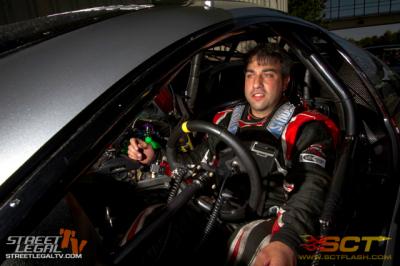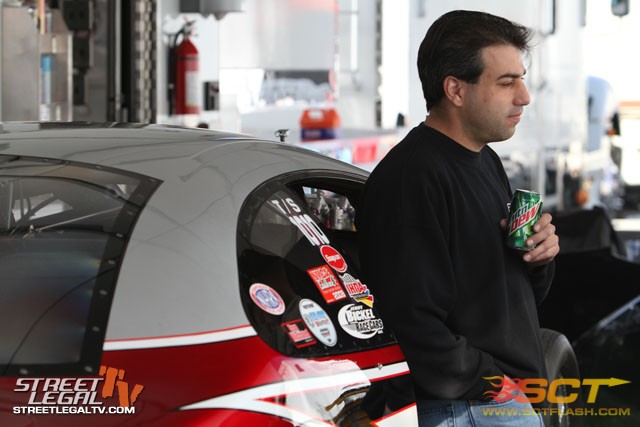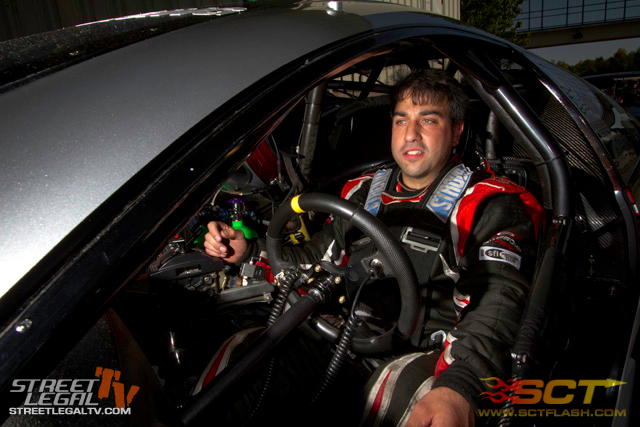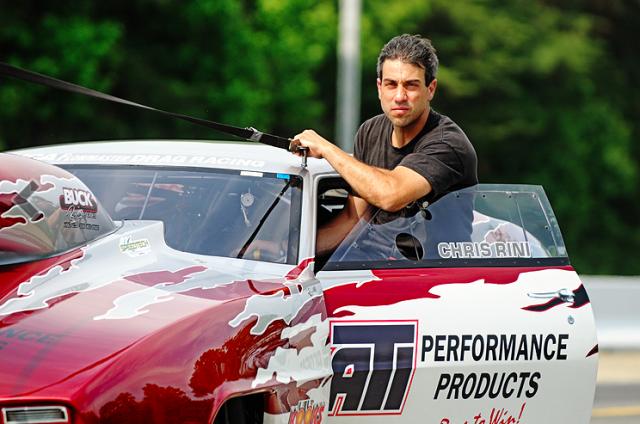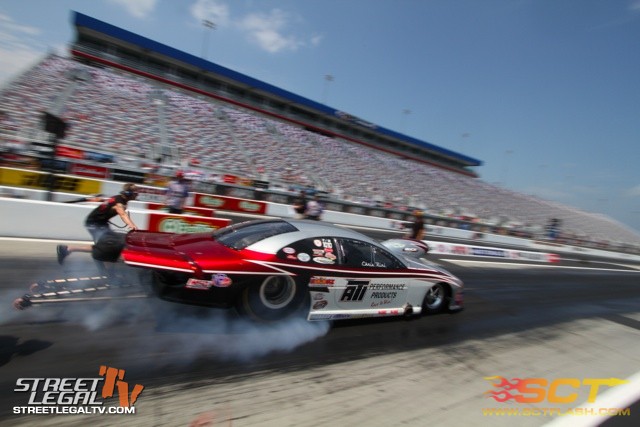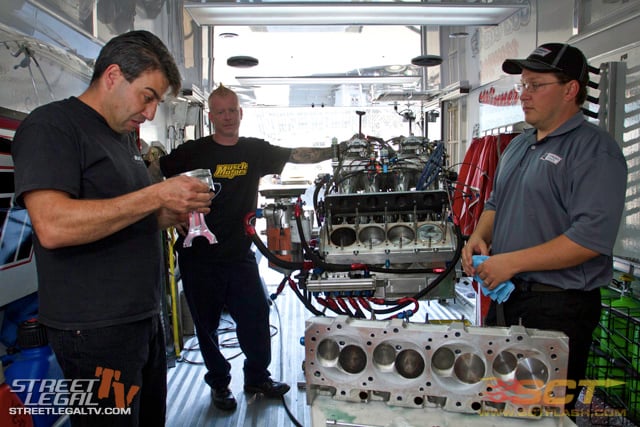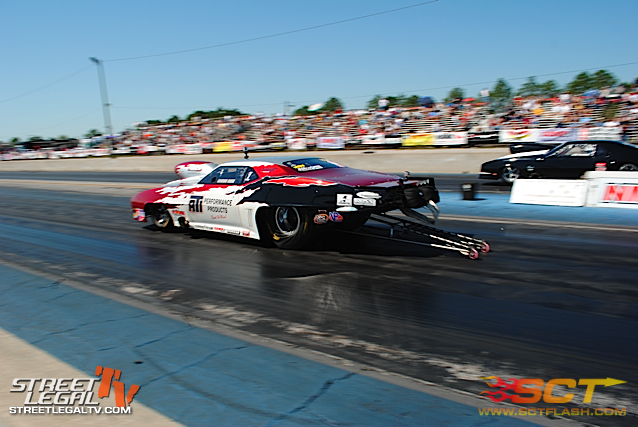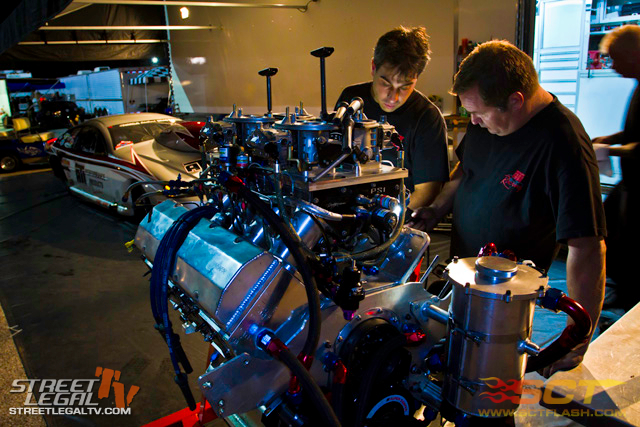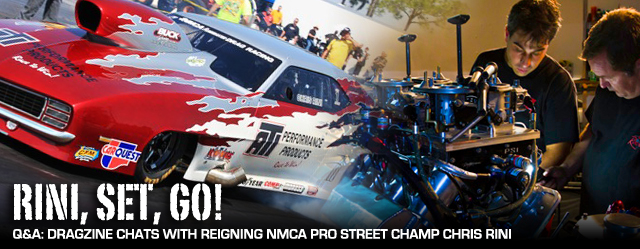 [1]
[1]
In the 1990’s, there was Christian, Musi, and Reiger. In the mid-2000’s, there was Budano. And today, there’s Rini. DRAGZINE recently sat down with reigning NMCA Pro Street champion and perennial national record holder Chris Rini, driver of the ATI Performance Products [2]-backed 1968 Camaro, to learn more about his introduction to the sport, his rise to the NMCA throne, and where the racing adventures of one of the most determined racers in the business might head next.
DRAGZINE: You really burst onto the scene in the Pro Street ranks, but where did you get you started in the sport?
Chris Rini: “I didn’t get involved in racing until around 2000. I built a street car and went to a couple of car shows with it, and that gets really boring really quick. Everyone stands around talking about how fast their car goes, so one day I loaded my car up on a flatbed trailer, and took it up to Lebanon Valley to see what it’d really run. That car kind of started the disease.”
“I went back a couple more times and they threw me out because I had a street car with no roll cage, no chute, no anything. We went 12.20 the first weekend out with DOT tires and full exhaust. I came back and put some nitrous on it, removed the exhaust, installed some slicks, and we went 10.20 without a cage and only a helmet and a pair of gloves. I may have bought a jacket. I made one or two runs and they ripped off my armband and said ‘you’re done,’ because the car just wasn’t legal.”
DZ: So how did you go from street car to race car?
Rini: “I bought a back-halved, purpose-bult race car in 2002 and that was my first real race car. It was a low nine-second, high eight-second car and I’d just take it up to the track and run test ‘n tune to see how fast I could make it go. That was really my only goal. At that point I realized up in the Northeast there’s really not any heads-up racing, at least not until the Northeast Pro Mods thing got moving. There was nothing within at least five hours of here, and so after running that car for a couple years, I bought an older Dodge Avenger and the only place I could bracket race and run fast was Top Sportsman.
” I started out racing Top Sportsman in Division 1 and ran there for a couple of years, but it just got kind of old putting a dial-in on the window and hitting the brakes at the finish line. My first year in Top Sportsman we just worked on getting the program figured out, because I’d never bracket raced before. We built a pretty fast car using an older chassis, and my second year in the class we finished fifth in the division, and my third year – which was my last in Top Sportsman – we finished third. But until 2000, I’d never even done a real burnout on a race track.”
DZ: How did you end up in Pro Street?
Rini: “During my third year in Top Sportsman, we went over to the NMCA with the same car to see if we could be competitive in Pro Street, and we were pretty consistent, but obviously we weren’t near as fast as the rest of the field. We were bottom-half qualifiers, but we had a lot of fun. I was actually invited over there by Vinny Budano, who was the reigning Pro Street champion at the time. They were looking to boost the car count and wanted some good cars and people who were interested in following the series. We ran a couple of the NMCA races up in the Northeast that year and the following season we started campaigning in Pro Street full-time.”
DZ: When you’re not racing, you operate your own business there in New York, correct?
Rini: “I opened up my business, Chris’ Automotive Center, when I was 20, after putting together some money from family and what I had in the bank. I took over an existing three-bay garage, and started out just doing some auto body work. It was just me and one helper, and before long we had another helper and I was working seven days a week if necessary. I had just one truck at the time: a twenty-five year old flatbed that used as much oil as it did gas. It was just humble beginnings where I did everything.”
“Within a couple years, I had developed a strong customer clientele, had added a couple other guys, and we outgrew that three-bay garage in three years. I moved the shop to a nine-bay garage here in Carmel and it was a dump, but it had a lot of potential. Other than the four walls and the roof, that’s all that’s left of the original building. Now, we’re a full service shop that doesn’t sub out anything. We’ve got seven tow trucks, 17 employees, and we do everything in-house, which isn’t too common in my area.”
DZ: How would you describe the current state of Pro Street racing?
Rini: “Pro Street is awesome, and we have a lot of fun there. The quarter mile format doesn’t bring in a lot of the southern racers unfortunately, but we run at some great, national event-quality tracks. I think the class is certainly growing despite the economic situation, but the guys that have the equipment already have the equipment, and their costs are just the weekend, so hopefully racers continue to show up.”
“We’ve got a lot of regulars and there’s a couple new racers that have come aboard this year and hopefully will join in as the year progresses. There are a lot of IHRA Pro Modified guys that don’t have anywhere to race now and we’re hoping they’ll come over and race Pro Street. The rules have been sort of laid back some to allow a Pro Mod car in without many changes, and that makes it a little more appealing to those guys.”
DZ: so do you feel that Pro Modified and Pro Street are finally becoming one in the same?
Rini: “I think they’re almost identical, especially the way they’ve laid out the rules. We used to be required to run headlights, taillights, a horn, and other things, but that’s not the case anymore. The Pro Street rules now are pretty well mimicked off of NHRA Pro Modified, with a couple of weight changes. But it’s nothing extreme.”
DZ: Do you see a time coming when Pro Modified racers will cross over and run with the NMCA?
Rini: “I don’t know why they wouldn’t. The rules will let them right in and the tracks are as good as anything they race on. The payout is decent, and if they need a place to race other than the NHRA, there’s another venue they can compete. It’s a great testing ground and they’d probably be treated better than they are in the NHRA. Most of those guys aren’t doing it for the money, it’s just about being treated well and having some fun.”
DZ: Do you ever wish that you could step back 10 or 15 years and race alongside, Musi, Christian, Reiger, Dantoni, and others?
Rini: “Sure I’d love to race some of the old-timers. I’ve really enjoyed seeing those guys come back out. Pat came back and that was great. I always tease him and tell him I can’t wait to line up alongside him and beat a legend. And Tony Christian, as old as he is, is still racing.”
“When we go test early in the year at open test sessions like at SGMP, we get to run alongside guys like Shannon Jenkins and Mike Castellana, and that’s great. At one point, you just read about those guys in magazines. When I was a little kid, I found a HOT ROD Magazine and I saw Tony Christian in there when he was in his heyday. It was definitely in black and white. Tony and Pat are really great guys, and I think in years past the rivalries were really personal because they were trying to do it as a livelihood, but now we’re friends with all the guys we race with in the NMCA.”
DZ: A big part of your success is testing. We’ve heard stories of you making 10-15 runs a day prior to a race. How often do you test and how big of a role has that played in where you are today?
Rini: “Our involvement with ATI has been a big deal for us. We go try out a new transmission or converter design or make some minor changes, and their new parts have about a 99% success rate, but the only way to find that out is to test. ATI has been behind me since the Top Sportsman days, and that’s been a real feather in my cap in moving forward.”
“I used to try testing one solid weekend a month or at least one day before every race we went to, and sometimes that would give us the edge that weekend. You’re always testing at a different racetrack in a different environment, but the things you try to see if they’re working you can apply during the race or in qualifying.”
“I just love testing. Of course I love racing and that’s really what it’s all about, but testing is the search and discover. But it’s a lot of work; you wear a lot of guys out that help you and you wear out a lot of parts and every run is an expense. And you might make four changes and their all in the wrong direction, but that’s what it takes to excel.”
DZ: What have been some of the major engineering milestones in your racing programs that has really helped you success?
Rini: “The Superglide 1, which was the first high-horsepower transmission that ATI ever made was what started it all. I’d broken three transmissions in one weekend at a Top Sportsman race where ATI was displaying on the midway, and Jim Beattie came over to me and said, “I’ve got a transmission that won’t break behind that thing.” And I told him, “everything that I’ve got is broken.”
“Jim sent me a Superglide and told me wouldn’t cash the check until I was happy. We used his transmission with another manufacturers’ converter – which he wasn’t happy about – and within the next three events we won a race. So I called and told him to cash my check and he said he’d do me one better and send me two of his converters. Right off the bat we picked up four mph, and three-hundredths on the first pass and we never looked back.”
“But our involvment with and the knowledge we’ve gained from people and companies like Charlie Buck, Speedtech Nitrous, Jerry Bickel Race Cars, and others is the kind of stuff you need t win races. To go out there and run fast once or twice doesn’t do you anything. It’s being able to go out there and go six rounds and qualify well and focus on racing and not focus on fixing things.”
DZ: Are you continually doing R&D to better your racing program?
Rini: “We try a lot of new things with Charlie that we research and test on the dyno and on the car, and we’ve done quite a bit of R&D with manufactures that I’ve gotten involved with that come out with products that aren’t on the market yet. Right now we’re running the Octobase, which is a new nitrous controller that’s got a lot of advantages over our older controllers. We’re also involved with XS Power and their lithium battery development.”
“I think our R&D kind of keeps us ahead of the pack. We get to work with developers and tell them how we feel and how changes could be made to make it better. Sometimes it hurts to be in the land of the unknown, and other times it helps you.”
DZ: If the NHRA’s ban on lockup-style converters was lifted, would you run NHRA Pro Modified?
Rini: “I can say with 100% certainty that we’d run there. And I don’t even understand why they have the ban in place. I think they just don’t understand it. A clutch car is locked up at the finish line, so why would a lockup converter not be allowed in Pro Modified in this day and age? I want to race there, but my primary sponsor is ATI and they make what I use and it helps my cars’ performance to have it in the car. But I’d be there in a heartbeat if we could get that rule changed.”
“Is it in there because they just don’t know any better, or because they don’t want automatics over there? Because honestly, the lockups help an automatic-equipped car compete in that format. It doesn’t offer any more advantage than if I put a clutch in my car. It just aggravates me because I can’t get a straight answer out of anybody.”
“I know NHRA is pretty sensitive about their oil downs due to time restrictions and scheduling, and I know in the past they’ve proven that they weren’t reliable and blew up and oiled the track, but we’ve made 400 runs between this and my previous cars with ATI transmissions and converters and never dumped a single transmission on the race track.”
“The advantage with an automatic car over in the NHRA is that they go down the track 9 times out of 10. This is all about entertainment and if you want to please the crowd, you need cars that go down the track, because eople want to see something pass by at 230 miles per hour and not shake or smoke the tires.”
DZ: Obviously you have a home with the NMCA, but you must have though about a full-on ADRL?
Rini: I think the ADRL is a great venue with an awesome environment, and I think it’s also the next level for financial exposure. To run with those guys that are the best of the best with unlimited funds, you’ve definitely got to put more money into your program, test more, and be willing to go out and wear your stuff out and replace it. And the costs just keeps rising. I’d love to run all of the ADRL races, but it’s a lot of time and expense for the travel, and if I had more money to work with, it’d certainly be an easier decision.
“If I went there, I’d want to be competitive. I don’t want to show up and just qualify. Right now, we’re running a Powerglide, which is a little bit of a disadvantage, but as we get a little faster and something falls into the schedule that’s closer to home, I’d love to run with them. I’d love to do a full-on ADRL program, it just takes a little more money and I think we’ve got to work on getting a little closer to the mark.”
DZ: Do you have any aspirations to advance up the drag racing ladder? Say, NHRA Pro Stock?
Rini: “Honestly, I’d love to try anything in drag racing. I think Pro Stock would be great, as would Pro Modified over in the NHRA, if we could get in there. I think the NHRA is a great place to race; they provide national exposure and the tracks are killer. I think it’d be fun and I’d like to run at Charlotte, but they won’t allow our combination to run right now.”
DZ: Your swim in the Hudson River has been well documented the last couple years. Do you still get a lot of fans that come up to you and ask about that event?
Rini: “Oh, definitely. That’s still a regular thing, although it happens less now than it did before. Sometimes they even still mention it when we roll up for qualifying. But I guess the exposure was good either way you look at it.”
DZ: It takes blood, sweat, and tears to be a champion. How do you make that happen?
Rini: “I do whatever needs to be done. If that means driving through the night to get to a race, test before a race because we’re not confident in something we’re trying, or we need to find some more speed and elapsed time, I’ll do whatever it takes to win. We’ll test all day somewhere and load up and drive twelve hours through the night to be at a race track, and if we don’t qualify or don’t run well, I’ll leave there and head to another track to test so we know we’re ready for the next one. Whatever needs to or has to be done, we’ll do. Thankfully, I’ve got great people and great manufacturers behind me.”
“We recently broke a driveshaft in qualifying and we changed everything but the engine that weekend and then we won the race. We go to the track with two of everything and we do what it takes, even if that means working through the night to fix something. We’re not just there for the barbecue.”
As anyone that’s ever lined up alongside the ATI-backed machine will attest, Chris Rini is as motivated and determined to excel as anyone in the sport and will admittedly only stop short of changing the race car at an event in order to do so. It’s that kind of personal drive that’s made Chris the man to beat in the NMCA Pro Street realm, and suffice it to say that regardless of the venue, the ATI Performance team will be hurtin’ some feelings for years to come.
